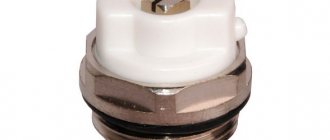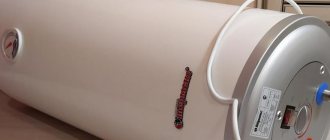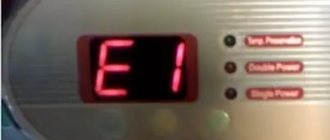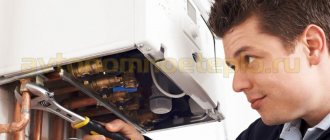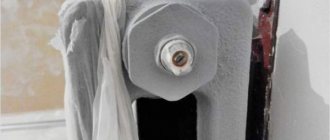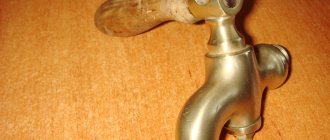What can we say about private houses in which there is no possibility of connecting to a centralized hot water supply. In general, in many cases a water heater is simply necessary in order to provide people with the necessary level of comfort. Fortunately, this equipment is becoming increasingly available. But after the purchase, it is not always possible to be happy with it, because sometimes various problems arise that very puzzle the inexperienced owner. For example, one of the most frequently asked questions is why does air accumulate in the boiler?
As a rule, there is only one symptom of this phenomenon - when you open the tap on the mixer, hot water seems to “spit out” from it in jerks, since air comes out along with it. There may be several reasons for this. Today we will look at the main ones, as well as how to bleed air from a water heater.
Possible reasons
But it also happens that the leak is located in a hidden place - for example, a pipe connection located in the floor or wall has leaked. Or it is so small that water is released literally a little at a time, but air still manages to get inside.
In the first case, finding the place of depressurization is, of course, quite difficult. That is why it is recommended that even when installing hidden wiring, it is possible to provide access to the main components. Otherwise, to find the right place you will have to disassemble the whole thing.
As for the second situation - that is, the presence of a very weak leak - you can find it using ordinary toilet paper. It absorbs water well, so even the slightest drop will be visible. Just apply the paper one by one to each joint of the elements and carefully inspect it after each action.
If the problem really is a leak, then the solution is obvious. It must be eliminated, thus eliminating both the danger of a breakthrough and further accumulation of air in the water heater.
We recommend reading:
As a rule, a check valve is included with the water heater. But cheap models often use not the highest quality elements. Therefore, the valve may fail. There is only one solution to the problem - replacing the element.
The third reason for the presence of air in the water heater is extremely simple - you have just installed the boiler. Naturally, at first the tank is filled with air, not water. To avoid problems with further use of the equipment, it must be started correctly. This is done in a certain sequence.
- Turn off the hot water supply using the shut-off valve.
- Open the hot tap on the faucet to remove any remaining water from the pipe. Then close it.
- Two pipes are connected to the bottom panel of the boiler. One is for cold water and is indicated in blue. The second one distributes hot food - the marking is, accordingly, red. Open the valve on the “cold” pipe, and then on the “hot” one.
- Now open the “hot” tap on the faucet again. First, air mixed with water will come out of the gander. It must be completely drained from the water heater. As soon as the gander has stopped “spitting” and you see that an even stream is coming out of it, the tap can be closed.
- Now we turn on the boiler, set the desired mode and wait for the water to fill and heat up. After this, you can fully enjoy a warm shower.
As you understand, if there is air in the boiler, you need to not only expel it, but also eliminate the cause of this phenomenon. Only in this case will the water heater bring you real comfort and serve for a long time and with high quality. Good luck!
An electric storage type water heater provides local hot water supply if there is no centralized one. The design of the unit is very simple. In order for it to last for a long time, periodic maintenance is necessary. To clean the tank and during breaks in operation, it is necessary to drain the water from the tank.
How to avoid mistakes when cleaning the boiler after draining the water
Many owners are faced with the problem of blockages inside the storage water heater. Often there is plaque on the heating element and the walls of the tank. It is this that can cause future failure of the unit. To prevent this from happening, you need to clean the inner surface. How to do this, see the instructions.
| Illustration | Description of action |
| Open the decorative cover, remove the nuts on the heater and wait until the remaining water has completely drained out. | |
| We take out the heating element and carefully remove large pieces of scale from it. | |
| We manually remove all the plaque we can get our hands on. | |
| Without removing the boiler, rinse it with running water and a watering can under pressure. Don't forget to substitute the basin. | |
| We insert the heating element into place, aligning the holes with the mounting bolts. | |
| We connect the wires according to the diagram with the heater. It is better to take a photo of the switching first. |
After completing all assembly stages, turn on the water and turn on the boiler.
If there are any unclear points about the drainage technology, ask questions in the comments. We will definitely answer you.
When draining is necessary
There are the following main situations when draining is necessary:
- Installation at the dacha. If the temperature in the house remains positive, and you plan to come every weekend and use the sink or shower, you don’t have to drain the boiler and leave it connected to the mains. Heating an already heated tank will not require a lot of energy; good thermal insulation of the tank will retain heat. If the boiler is connected to a dacha that is used only during the warm season, it (like the entire water supply system) cannot be left undrained for the winter. The ice will expand and rupture the pipes and tank of the unit. You can't do without a drain here.
- Use in a city house with a seasonal lack of hot water supply. A rupture does not threaten, but another risk arises: stagnation will begin in the water heater, and algae, mold and microorganisms will begin to multiply in the heat. Medium-power biological weapons will be brewing right next to you. You will also need to drain the liquid completely. If you dry the tank well, this will also help preserve its walls and heating elements from corrosion.
- Occasional use. It often happens that interruptions in hot water supply occur once a week. Then it's better not to drain it. In a week or two, the microflora development processes will not have time to go far, and frequent assembly and disassembly of the device will shorten its service life.
Consumers connected to the centralized water supply receive water after disinfection. There are so few microbes in it that they do not have time to multiply to alarming numbers.
If the water heater is supplied from a well or a well, once a month it is necessary to refresh the water in it, then turn on and warm up the device to the maximum.
How to drain popular brands of water heaters
The general design of boilers of different brands is very similar. Despite this, there are differences between them in the procedure for draining.
Ariston
The manufacturers of this popular brand recommend draining it if the appliance is not used for more than three weeks.
The drain hose (green) is connected to the drain pipe
Draining is carried out like this:
- Disconnect the boiler. Allow to cool to at least 40°C.
- Close the cold water valve.
- Open the hot tap on the mixer. Some of the liquid is drained and the pressure is relieved.
- Open the cold water valve.
- Place a flexible drain hose onto the drain valve located on the supply pipe.
- Open the drain valve and drain the liquid. This will take quite a long time, depending on the tank capacity.
When draining is complete, disconnect the hose and close the tap.
Thermex
An equally popular brand also requires draining during a long break in operation.
Boiler drain - unscrewed connections
Before you begin, you should disconnect the device from the power supply. After this, you need to let it cool to at least 40 o C to avoid burns.
Next you should proceed as follows:
- Close the cold water valve.
- Open the hot water tap on the mixer. Some of the water is drained and the pressure is relieved.
- Unscrew the nut under the emergency valve.
- Attach a flexible drainage hose there.
- Unscrew the nut on the outlet pipe, allowing air access. The drain hose will begin to drain.
After draining is completed, the unscrewed nuts must be tightened.
Bosch
Bosh boilers are connected according to one of two schemes:
Regardless of the scheme, you first need to disconnect the device from the network and wait for it to cool down.
With the usual scheme:
- Open the hot tap of the mixer. Some liquid is drained; the tap should be left open.
- Attach a flexible drain hose to the pipe next to the emergency valve.
- Raise the valve lever and drain the liquid from the tank.
- Lower the lever.
With a simplified scheme:
- Open the hot tap of the mixer. The tap should be left open.
- Connect the hose to the nipple of the emergency valve. You can drain it into a container, placing it under the boiler. You need to carefully monitor the water level so as not to forget to pour it out in a timely manner.
- Open the valve by lifting the lever. Drain the water. A 100 liter tank will take three to four hours.
- If there is no lever, you need to press out the spring inside it with a screwdriver or a rod.
To speed up the drainage, open the valve on the outlet pipe.
Haier and Electrolux units are drained in the same order.
Atlantic
First you need to turn off the power to the device and let it cool.
If, when installing a system, they try to save on small things, then they do not install taps, connecting the pipes directly.
If the drain valve is working properly, open it and drain the water into the drain or into a substitute container.
If cut-off valves are not installed, then do this:
- Disable the riser.
- Unscrew the nut of the outlet pipe.
- Unscrew the nut of the inlet pipe.
- Raise the valve lever and wait for it to flow completely.
Features of draining water from boilers of different brands
Organization of hot water supply using high-quality water heaters is considered quite reliable. But sometimes you have to get rid of the collected liquid, for example, to clean an electrical appliance or when it breaks down. Using popular brands as an example, let's look at how to empty a water heater without the help of specialists.
Boiler from TC "Ariston"
- Unplug the device and wait until the water reaches the optimal temperature to avoid getting burned.
- Shut off the water supply to the boiler using a specially installed regulator.
- Open the hot water tap on the mixer closest to the boiler. This will allow air to penetrate inside the tank.
- Turn the air intake valve to the “ON” position, then open the drain valve, through which water will come out.
To completely clean the inside of the electrical appliance, you will have to completely remove the heating device. Ideally, it should be boiled in a metal container by adding citric acid.
Boiler from the Thermes brand
For safety reasons, you must disconnect the device from the network before continuing.
- We completely shut off the stationary water supply and remove the tubes that supply water to the heater tank.
- If you are using a flat-type boiler, then simply stop the water supply and pour the remaining water through the hot tap on the mixer.
The principle of drainage, depending on the volume of the heater and the complexity of its design, may differ.
Electrolux water heater
Boiler models from the Electrolux brand are several times easier to drain than any other model. Typically, release is through a drain valve.
For more details on the drain algorithm, see the video.
Drain rules depending on the type of connection
There are general rules for draining a boiler, depending on the type of installation diagram used.
Standard connection (with tee)
Most manufacturers recommend using this scheme. It is more difficult to install and costs more in terms of materials and components. But the liquid can be drained without using tools and with a minimum of effort and time.
The scheme includes the following elements:
- Boiler.
- Cold water valve.
- Emergency valve.
- Tee and drain valve.
- Hot tap on mixer.
- Cold tap.
- Mixer spout.
- Hot water valve.
This installation method allows for complete drainage in 15-20 minutes.
The sequence of actions is as follows:
- Disconnect the device from power. There is no need to wait for cooling.
- Close valve (2).
- Open the tap (5), drain water through the spout (7) into the sink.
- Leave the tap open, allowing air to enter.
- Connect a hose to the pipe coming out of the valve (4).
- Open valve (4) and drain the liquid into the drain.
- After finishing the drainage, close the valve (8).
If the water flows out slowly, you can connect a compressor to the tap and pump air into the tank. This will significantly speed up the process.
Often, during installation, the drain pipe is immediately connected by a pipe to the drain. Then draining will be even more convenient - your hands will definitely remain dry.
When starting the water heater, open valve (8), close (5) and (4). After this, you can open the valve (2) and fill the tank, and then plug the device into the network.
Permanent drainage connection (middle tube)
Improved Connectivity
Installing tees on both the cold and hot water sides significantly increases the ease of use of the system. Drainage work is carried out as follows:
- Close the inlet valve.
- Connect the drain hose for the drained liquid.
- Open the hot tap on the mixer, reduce the pressure and partially drain the water.
- Open the valve on the tee of the hot water pipe. Give access to air, water will flow out through the drainage hose.
This scheme only simplifies the work of the plumber installing the device. Saving a penny on several valves, pipes and fittings will add a lot of worries to the boiler owner.
How to drain water from the boiler depending on the connection method
There are several options for installing a water heater. Depending on these factors, the methods for draining the contents will vary. In each specific case, there is a strict sequence that must be followed in order not to make mistakes.
With standard installation method
For this design, simple switching of pipes is provided. When connecting them to a boiler in a small area, be sure to install a tee in front of the pressure relief valve. A valve is usually installed on it, with the help of which the drain is performed. Therefore, no additional tools are required for this method of emptying the tank. If all pipes are connected correctly, it will take about 10 minutes to drain the water.
Above, see the connection diagram of all parts with the water heater.
When an improved method is used
In such a situation, it is necessary to install two tees, which are attached not only to the inlet pipeline, but also to the outlet. To drain the water with such a connection system, you must perform the following steps:
- turn off the water supply tap;
- open the mixer valve;
- connect a hose to the outlet and direct it into the container;
- activate the safety valve by opening the air supply at the tee.
Floor-standing boilers have a similar method of emptying, provided that their installation is carried out in an improved way.
Simplified installation option
The simplified connection method involves only connecting flexible hoses to the cold and hot pipes. To drain in this case, you should open the hot valve, while preventing the flow of water into the tank. Then, you should substitute the container and open the safety valve flag. If the water is discharged too slowly, you can completely disconnect the hot line from the appliance. The main thing here is to choose a sufficient container for receiving water.
If during the process of emptying the tank you do not want to remove the fuse, then it must be fixed in the open position so that the spring does not fall and block the outlet channel.
How to bleed air from a water heater.
After draining and then filling the boiler, it happens that air gets into it, forming a plug. At the same time, hot water flows in a thin stream, gurgling can be heard in the body of the device.
To remove the blockage you need to do the following:
- Take a piece of flexible hose and tape.
- Connect the cold faucet to the hot faucet with a hose. For reliability, secure the hose with tape.
- Open the hot tap.
- Open the cold water tap for a few seconds.
- Check the flow of hot water in another faucet.
- If it doesn’t work out the first time, repeat steps 3-5 several times.
If you managed to remove the plug, close all taps and remove the hose. If that doesn’t work, it’s better to call an experienced plumber.
In many apartments and private houses, boilers are installed to provide hot water. The service life of such devices largely depends on tap water - if it is too hard, then scale will form on the walls of the internal tank and heating element. This can be avoided by periodically carrying out preventive maintenance, which consists of cleaning the inner surface of the boiler. Experienced specialists know how to quickly and competently drain water from the device. But a person who is faced with a similar problem for the first time must first delve into all the nuances of the process. How to drain water from a boiler will be discussed in this article.
How to drain water from a boiler
Features of draining water with your own hands
If the tank is supported or hung from a wall, it is most likely in a vertical position. This is convenient if you have to drain. This way you can completely empty the internal volume. Water can be drained through a hose connected to the cold pipe or by activating the drain valve. However, in order to perform the operation correctly, you need to know some subtleties, which will be discussed below.
We use a safety valve
The drain safety valve is a device for the emergency release of water. It is installed at the lowest point of the heater. It is usually attached to a hot or cold tube. When the pressure inside the container increases, the valve is activated, releasing excess pressure to the outside. If you look at the drain device, you will notice that it has a channel with a small diameter. It serves to allow the connection of a miniature drain tube. Once the connection is made, you can activate the valve and release the water.
The only drawback of this method is that due to the small diameter of the tube, the process will take about two hours. If the valve is clogged, the water will drain even more slowly. The drain time will increase by 3-4 hours.
How to drain water using a cold pipe
This solution to the problem is allowed only when the owner has plumbing skills. In order to release water from the tank, it is necessary to prepare an adjustable wrench. Follow the instructions below:
- We turn off the water on the main line and be sure to disconnect the boiler from the electricity.
- To control the process of water release, it is necessary to check the closure of the hot water tap in the bathroom and kitchen.
- Having prepared a container for collecting water, unscrew the nut connecting the cold line to the boiler and begin the descent.
- Be sure to unscrew the safety valve, assess its condition and readiness for further work.
- To quickly drain, open the hot water tap and adjust the pressure with this part of the mixer.
- Some designs have an additional valve on the hot pipe. If you adjust its rotation, you can achieve the optimal water drainage speed.
Do not under any circumstances carry out work while the boiler is plugged in - this may result in electric shock.
Using water intake and return pipes
Inlet and outlet hoses allow water to be drained. All the owner needs to do is unscrew both hoses or plastic pipes. After this, draining will begin immediately.
This method should be used if the tank is installed directly above the bathtub, because it will be impossible to stop the flow until all the water has drained out. This way the tank is emptied within 3-5 minutes. To drain in this way, the safety valves must be removed. To install them in their original place, you must use new sealants.
When should you drain the water?
When, in addition to cleaning the inner surface of the tank and heating element, is it necessary to drain water from the boiler? This question should be of interest primarily to those who use the water heater irregularly. In country houses where the owners visit only on weekends in the summer, the water must be drained in cases where the temperature may drop to 5 degrees Celsius while the boiler is not in use. There is a possibility that the coolant will freeze at this temperature and, as a result, the tank in the boiler will rupture.
The water temperature in the boiler must not fall below +5 degrees
Note! If the temperature does not drop below +5 degrees, then it is better not to touch the device at all, since manufacturers categorically do not recommend leaving water heaters without liquid for a long time. Otherwise, a number of processes may occur that worsen the condition of the storage tank.
There is no need to be afraid that the water in the tank will spoil. After a long “stagnation”, you just need to pass it through the tap, and the next “batch” can already be used. By the way, the magnesium rod works effectively even when completely immersed in water, and perfectly prevents rust.
After stagnation, the water must be passed through the tap
The vast majority of manufacturers also do not recommend draining the water frequently, because a tank without liquid will corrode much faster. Experienced people said about this: a thing created to be in water must be in it.
Boiler operation diagram
Often, draining water is motivated by an unpleasant odor that appears inside the device if the water has not been drained for a long time. In this case, you can resort to a little trick: if the pipeline water comes with impurities (such as hydrogen sulfide), then the boiler should be dehydrated even for short-term downtimes. You can drain the water from it each time, and when filling it for the first time, heat it up as much as possible.
Video - How to get rid of the unpleasant smell of water in the boiler?
How to drain water from a boiler
A boiler is a container that operates at high pressure, so it will not be possible to drain water from it by opening a hot water tap and turning off the previously cold water supply. This can be easily guessed if we consider the operating principle of a storage water heater. If you try to do this, you will only drain the water located above the hot water supply pipe, and not necessarily completely. It is necessary that air enters the tank - and this is done using the same hot water pipe. Let's consider how this procedure will occur.
Step 1. First, you need to de-energize the boiler, that is, simply remove the plug from the socket.
First the boiler must be de-energized
Step 2. Next, you need to turn off the cold water supply (turn off the tap).
You also need to turn off the cold water supply
Step 3. Having previously placed a basin or any other suitable container, you can begin to unscrew the cold water tubes. By the way, the connecting tubes that connect the boiler to the water supply and consumption systems can be metal-plastic, simply plastic or made of a flexible hose. Craftsmen advise giving preference to metal-plastic products, since they are more reliable and also look more attractive.
You can start unscrewing the tubes
How to remove residual water from a water heater?
As noted above, after draining the water, some of it will still remain inside the tank. And to completely empty the tank, you will need to remove the heating element. To do this, you can follow the algorithm below:
- remove the special casing, having first disconnected all electrical components;
- once again place a basin or any other container designed to collect dirty liquid and debris;
- unscrew the heating element. You may have to make a lot of effort, since during the manufacture of boilers the heating elements are screwed very tightly. Then, after removing the heating element, the water will immediately begin to flow into the basin.
Any owner can replace the heating element
Of course, it is better to take into account the possibility of needing to drain the water and make all connections removable. And if the water needs to be drained frequently, then it is advisable to install tees on the supply/drain of the device (the tees must have taps to drain the water).
Video - How to drain water from a water heater, boiler
Note! Due to the fact that the cold water supply pipe still has some height, there will still be water in the tank (out of 100 liters - no more than 10-15), even if it seems that all the liquid has already been drained. This must be taken into account if you do not plan to use the boiler in winter. To get rid of all the water, you need to unscrew the heating element and drain the water through the mounting hole.
For complete cleaning, you need to remove the heating element and drain the water through the mounting hole.
Properly getting rid of residual water in the boiler
Regardless of which drainage method you choose, some water may remain at the bottom of the boiler. In order to get rid of it, you should perform a few simple manipulations:
- After the main drain, you need to remove the bottom plastic cover.
- Next, carefully remove the wires from the signal lamp, be sure to disconnect the wiring.
- If you doubt that you will remember the switching sequence, take a photo with your phone.
- Unscrew the heating element counterclockwise, holding it a little to allow the liquid to slowly flow out.
- Carefully remove the heater from the container so as not to damage it on the metal body of the boiler.
- If resistance is felt, do not try to pull out the heating element by force. It is worth shaking it left and right and carefully remove it from the device.
If, after completely draining the heater, scale is found, then it’s time to think about a fine filter.
When NOT to flush the water
There is no need to drain the water from the boiler if it breaks down during the warranty period. Contact the service center immediately - they should look for the cause and eliminate the malfunction. In most cases, boilers are repaired at home, like any other large equipment.
Warranty boiler repair
